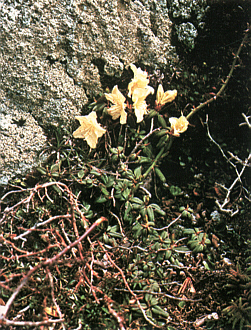QBARS - v26n2 R. keiskei 'Yaku Fairy'
R. keiskei 'Yaku Fairy'
Warren Berg, Kent, Washington

|
|
R. keiskei
|
It is certainly fitting that the rare prostrate form of the Japanese R. keiskei is found only on the highest reaches of the famous Island of Yakushima, the home of the remarkable R. yakushimanum . Finding this lonely little gem, blooming among the rocks, on what seemed the top of the world, with R. yakushimanum growing as far as the eye could see, was an experience and sight beyond description. This little plant is completely prostrate and mat forming, and the area it occupies is exceedingly small. Although collecting is prohibited by law, it is in real danger of becoming extinct.
Mr. K. Wada has referred to this new form of R. keiskei as the "fairy" rhododendron of Yaku. It has thus been appropriately named 'Yaku Fairy' by Mr. Barry Starling of England. Mr. Starling received the Award of Merit from the R. H. S. when his plant was shown for the first time in 1970. There is a complete description in the 1971 R. H. S. yearbook. It is interesting to note that Mr. Davidian, from Edinburgh, confirmed the identity of this particular keiskei , but Captain Collingwood Ingram who is also very knowledgeable, considers it to be a new species ( R. trichocalyx ).
The original plant, which I also obtained from Mr. Wada about six or seven years ago, has remained prostrate in cultivation and is now approximately 15" in diameter and only about 3" high. It retains its fine looking foliage all winter and blooms three or four weeks after the popular dwarf form. This is fortunate for me because of the late spring frosts. Reports from the east would indicate it is also a more hardy form. Considering its native habitat, this is undoubtedly true. It is also easy to propagate, comes true from seed and starts blooming at an early age. I have made quite a few crosses that look very promising, particularly since many of the hybrid seedlings retain the prostrate habit of the parent. All the signs indicate that this little rhododendron will become a popular garden plant with rhododendron enthusiasts, and in time, with the gardening public in general. It is being propagated and will be circulated before very long.
